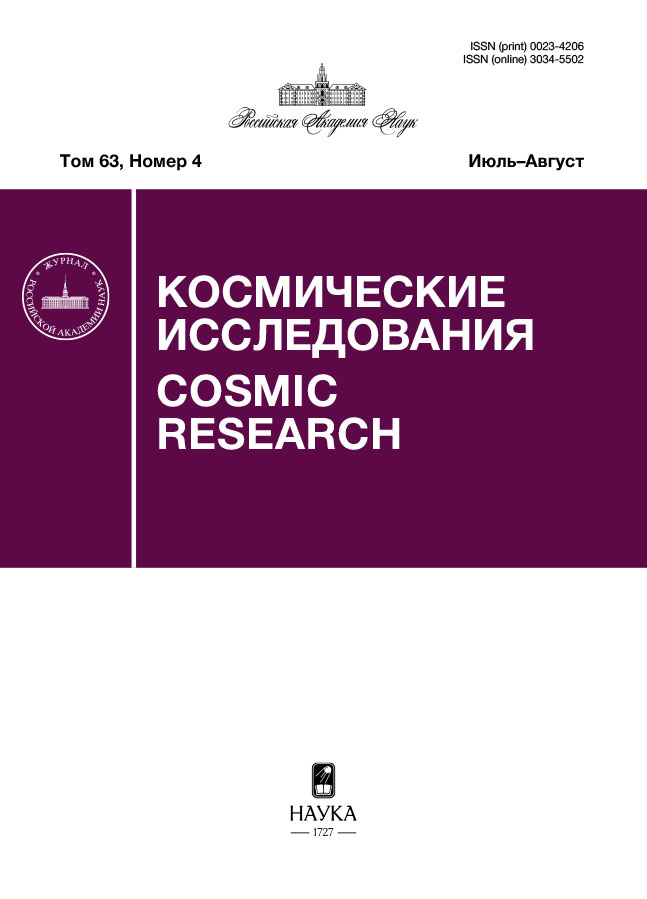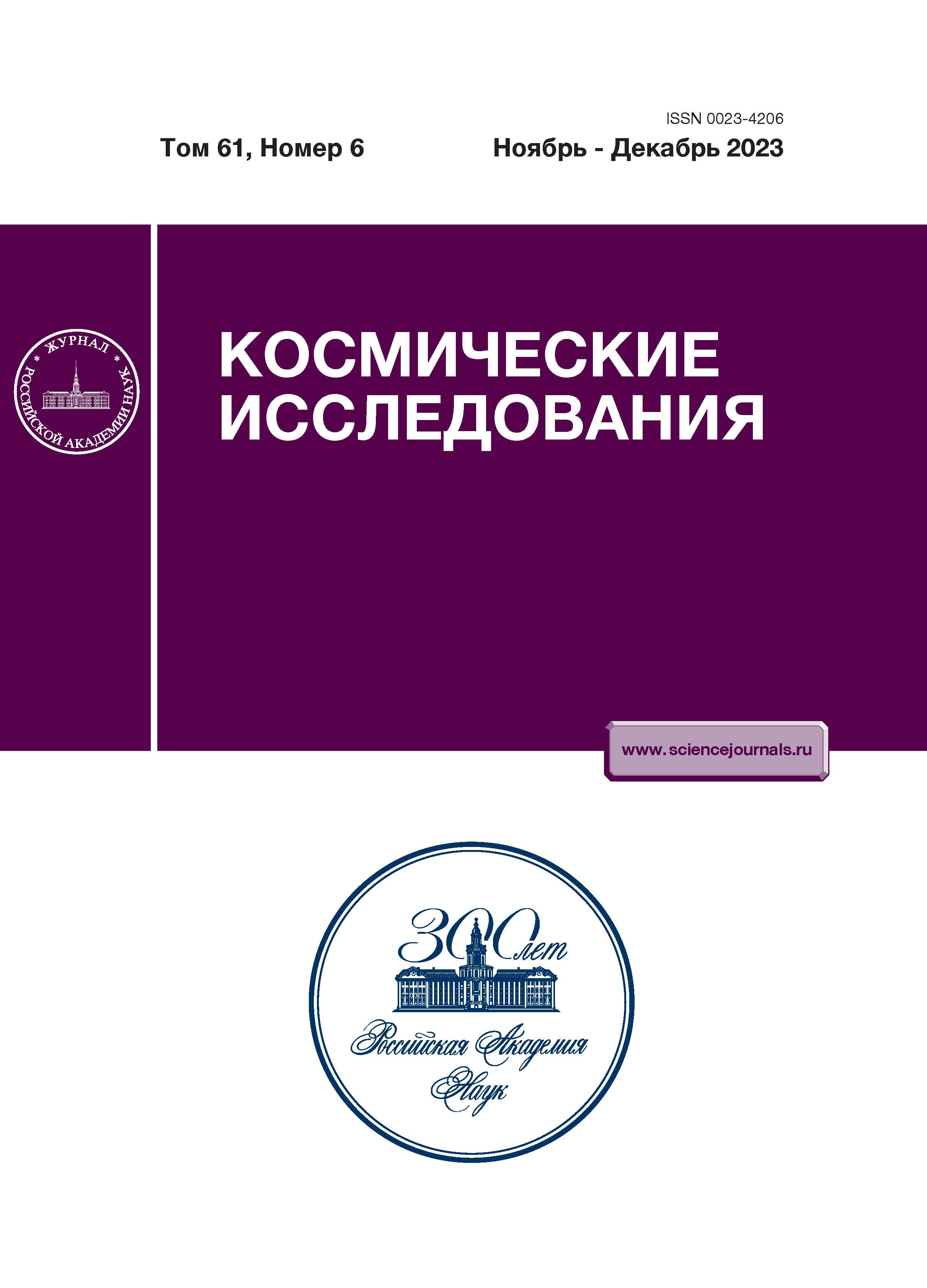Характеристики узкополосного искусственного радиоизлучения ионосферы в зависимости от эффективной мощности излучения нагревного стенда EISCAT/Heating
- Авторы: Калишин А.С.1, Благовещенская Н.Ф.1, Борисова Т.Д.1, Егоров И.М.1, Загорский Г.А.1, Ковалев А.С.1
-
Учреждения:
- Арктический и антарктический научно-исследовательский институт
- Выпуск: Том 61, № 6 (2023)
- Страницы: 476-485
- Раздел: Статьи
- URL: https://rjsocmed.com/0023-4206/article/view/672565
- DOI: https://doi.org/10.31857/S0023420623600204
- EDN: https://elibrary.ru/CFXKDA
- ID: 672565
Цитировать
Полный текст
Аннотация
По данным экспериментов на нагревном стенде EISCAT/Heating при ступенчатом изменении эффективной мощности излучения выполнена оценка порогов возбуждения и анализ зависимости спектральных характеристик узкополосного искусственного радиоизлучения ионосферы (УИРИ) от напряженности электрического поля мощной радиоволны КВ-диапазона (волны накачки) необыкновенной поляризации (Х-мода). Волны накачки излучались в направлении магнитного зенита на частоте 5.423 МГц. Эффективная мощность излучаемой волны изменялась от 55 до 360 МВт. УИРИ регистрировалось на научно-исследовательской станции под Санкт-Петербургом на расстоянии ∼1200 км от нагревного стенда. Выполнены расчеты напряженности электрического поля мощного КВ-излучения вблизи высоты отражения с учетом неотклоняющего поглощения на пути распространения. Определены пороговые (минимальные) значения электрического поля, необходимые для возбуждения УИРИ.
Об авторах
А. С. Калишин
Арктический и антарктический научно-исследовательский институт
Email: askalishin@aari.ru
Россия, Санкт-Петербург
Н. Ф. Благовещенская
Арктический и антарктический научно-исследовательский институт
Email: askalishin@aari.ru
Россия, Санкт-Петербург
Т. Д. Борисова
Арктический и антарктический научно-исследовательский институт
Email: askalishin@aari.ru
Россия, Санкт-Петербург
И. М. Егоров
Арктический и антарктический научно-исследовательский институт
Email: askalishin@aari.ru
Россия, Санкт-Петербург
Г. А. Загорский
Арктический и антарктический научно-исследовательский институт
Email: askalishin@aari.ru
Россия, Санкт-Петербург
А. С. Ковалев
Арктический и антарктический научно-исследовательский институт
Автор, ответственный за переписку.
Email: askalishin@aari.ru
Россия, Санкт-Петербург
Список литературы
- Thidé B., Kopka H., Stubbe P. Observations of stimulated scattering of a strong high frequency radio wave in the ionosphere // Physics Review Lett. 1982. V. 49. P. 1561–1564. https://doi.org/10.1103/physrevlett.49.1561
- Frolov V.L., Sergeev E.N., Ermakova G.P. et al. Spectral features of stimulated electromagnetic emissions, measured in the 4.3–9.5 MHz pump wave frequency range // Geophys. Res. Lett. 2001. V. 28. P. 3103–3106.
- Leyser T.B. Stimulated electromagnetic emissions by high-frequency electromagnetic pumping of the ionospheric plasma // Space Science Reviews. 2001. V. 98. P. 223–328. https://doi.org/10.1023/a:1013875603938
- Фролов В.Л. Искусственная турбулентность среднеширотной ионосферы. H. Новгород: Изд-во ННГУ им. Н.И. Лобачевского, 2017. ISBN 978-5-91326-355-1.
- Bernhardt P.A., Selcher C.A., Lehmberg R.H. et al. Determination of the electron temperature in the modified ionosphere over HAARP using the HF pumped Stimulated Brillouin Scatter (SBS) emission lines // Ann. Geophys. 2009. V. 27. P. 4409–4427.
- Mahmoudian A., Scales W.A., Bernhardt P.A. et al. Investigation of ionospheric stimulated Brillouin scatter generated at pump frequencies near electron gyroharmonics // Radio Science. 2013. V. 48. P 685–697. https://doi.org/10.1002/2013RS005189
- Yellu A.D., Scales W.A., Mahmoudian A. et al. First Observations of Narrowband Stimulated Electromagnetic Emissions at the Pump Frequency Second Harmonic During Ionosphere Interaction Experiments // Geophysical Research Letters. 2018. V. 45. P. 8690–8697. https://doi.org/10.1029/2018GL078924
- Shukla P.K., Stenflo L. Stimulated Brillouin scattering of electromagnetic waves in magnetized plasmas // J. Plasma Physics. 2010. V. 76. P. 853–855.
- Samimi A., Scales W.A., Bernhardt P.A. et al. Ion gyroharmonic structures in stimulated radiation during second electron gyroharmonic heating: 2. Simulations // J. Geophysical Research: Space Physics. 2014. V. 119. P. 462–478. https://doi.org/10.1002/2013JA019341
- Fu H.Y., Jiang M.L., Wang K.N. et al. Electron temperature inversion by stimulated brillouin scattering during electron gyro-harmonic heating at EISCAT // Geophysical Research Lett. 2020. V. 47. Iss. 17. https://doi.org/10.1029/2020GL089747
- Kalishin A.S., Blagoveshchenskaya N.F., Borisova T.D. et al. Ion Gyro-Harmonic Structures in Stimulated Emission Excited by X-Mode High Power HF Radio Waves at EISCAT // J. Geophysical Research: Space Physics. 2021. V. 126. Art. ID. e2020JA028989. https://doi.org/10.1029/2020JA028989
- Kalishin A.S., Blagoveshchenskaya N.F., Borisova T.D. et al. Comparison of Spectral Features of Narrowband Stimulated Electromagnetic Emission Excited by an Extraordinary Pump Wave in the High-latitude Ionospheric F Region at Frequencies be low and above the F2 Layer X-component Critical Frequency // Russian Meteorology and Hydrology. 2022. V. 47. Iss. 12. P. 921–930. https://doi.org/10.3103/S1068373922120032
- Blagoveshchenskaya N.F., Borisova T.D., Kalishin A.S. et al. First observations of electron gyro-harmonic effects under X-mode HF pumping the high latitude ionospheric F-region // J. Atmospheric and Solar-Terrestrial Physics. 2017. V. 155. P. 36–49. https://doi.org/10.1016/j.jastp.2017.02.003
- Blagoveshchenskaya N.F., Borisova T.D., Yeoman T.K. Modification of the high latitude ionosphere F region by X-mode powerful HF radio waves: Experimental results from multi-instrument diagnostics // J. Atmospheric and Solar-Terrestrial Physics. 2015. V. 135. P. 50–63. https://doi.org/10.1016/j.jastp.2015.10.009
- Blagoveshchenskaya N.F., Borisova T.D., Kalishin A.S. et al. Comparison of the effects induced by the ordinary (O‑mode) and extraordinary (X-mode) polarized powerful HF radio waves in the high-latitude ionospheric F-region // Cosmic Research. 2018. V. 56. P. 11–25. https://doi.org/10.1134/S0010952518010045
- Rietveld M.T., Senior A., Markkanen J., Westman A. New capabilities of the upgraded EISCAT high-power HF facility // Radio Sci. 2016. V. 51. Iss. 9. P. 1533–1546. https://doi.org/10.1002/2016RS006093
- Rietveld M.T., Wright J.W., Zabotin N. et al. The Tromsø dynasonde // Polar Science. 2008. V. 2. P. 55–71. https://doi.org/10.1016/j.polar.2008.02.001
- Rishbeth H., van Eyken A.P. EISCAT – early history and the first ten years of operation // J. Atmos. Terr. Phys. 1993. V. 55. Iss. 4–5. P. 525–542.
- Lehtinen M.S., Huuskonen A. General incoherent scatter analysis and GUISDAP // J. Atmos. Sol. Terr. Phys. 1996. V. 58. P. 435–452.
- Kalishin A.S., Blagoveshchenskaya N.F., Borisova T.D. et al. Remote Diagnostics of Effects Induced by High-latitude Heating Facilities // Russian Meteorology and Hydrology. 2021. V. 46. P. 231–240. https://doi.org/10.3103/S1068373921040038
- Gurevich A.V. Nonlinear effects in the ionosphere // Physics-Uspekhi. 2007. V. 50. P. 1091–1121.
- Robinson T.R. The heating of the high latitude ionosphere by high power radio waves // Phys. Rep. 1989. V. 179. P. 79–209.
- Борисова Т.Д., Благовещенская Н.Ф., Калишин А.C. Особенности возбуждения искусственной ионосферной турбулентности при О- и Х-нагреве вблизи критической частоты слоя F2 // Солнечно-земная физика. 2023. Т. 9. № 1. С. 3–18. https://doi.org/10.12737/szf-81202201
Дополнительные файлы


















